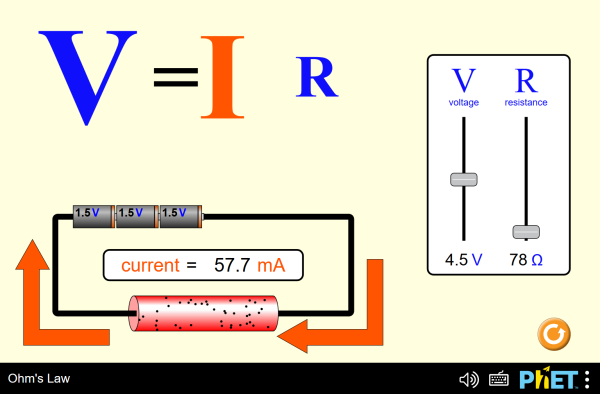Ohm's Law - Relationship between current and voltage.

⇒
Here , when the Potential difference of 0 voltage is applied the
ammeter in the circuit reads 0 amps , when it is increased to 5 voltage
the ammeter reads 1 amps which is verified using the formula - The voltage across an element is directly Proportional to the current flowing.
- V∝i
Where: R=resistor ⇒ Has ability to resist the flow of electric current.

Take note:
- Resistors has no polarity
- Not flows - to +
- The value of R :: Varies from 0 to infinity
- Extreme values == 0 and infinity
- Only linear resistors obey ohm's law

- The transmission lines, the top one terminated at an open circuit, the bottom terminated at a short circuit. Black dots represents electrons, and the arrows show the electric field.
CONDUCTANCE
⇒ The ability to conduct electric current flow.- unit (mho) or (siemens)
- symbol S
- Reciprocal of the resistance R (G= 1/R)
POWER

- R and G are positive quantities, thus power is always POSITIVE.
- R absorbs power from the circuit → PASSIVE ELEMENT
EXAMPLE 1
- Determine voltage (v), conductance (G) and power (p) from the figure below.

Solution:
For voltage:
v=iR=(2*10^-3)(10*10^3)
v=20V
For Conductance:
G=i/R=1/10*10^3
G=1*10^-4
For Power:
P=t^2R=v^2/R
=(2*10^-3)^2 (10*10^3)
=0.04 w
=40mW
=(20)^2/10*10^3
P=0.04 w
EXAMPLE 2
- Calculate current i in figure below when the switch is in position 1.
- Find the current when the switch is in position 2.

Solution:
(a) i = 3/100 = 30 mA
(b) i = 3/150 = 20 mA
LEARNING/SUMMARY
Everything around us is connected or related with each other. So, therefore, in dealing with circuit analysis, everything is also related. One element might be directly proportional. It could be that another element is inversely proportional to the other. But the point is, if one has been measured or calculated mistakenly, everything will be reversed to be wrong.
So, therefore, if you have not understood the basics, it would be hard for you to go through. So, go back to the previous lessons and come back to deal with this topic.
TRY THIS! ↓↓↓
https://phet.colorado.edu/sims/html/ohms-law/latest/ohms-law_en.html| Click to Run |

No comments:
Post a Comment